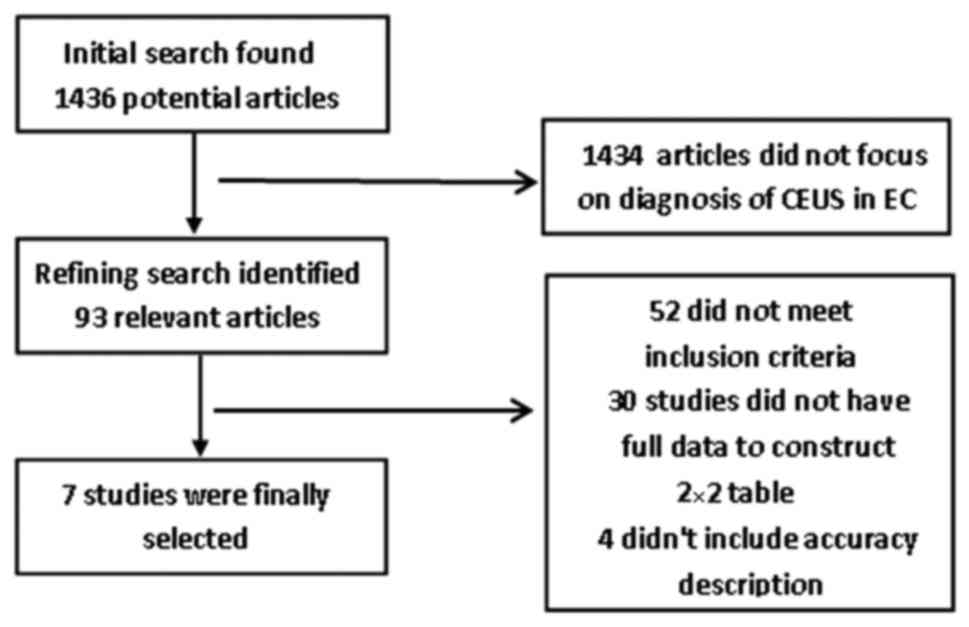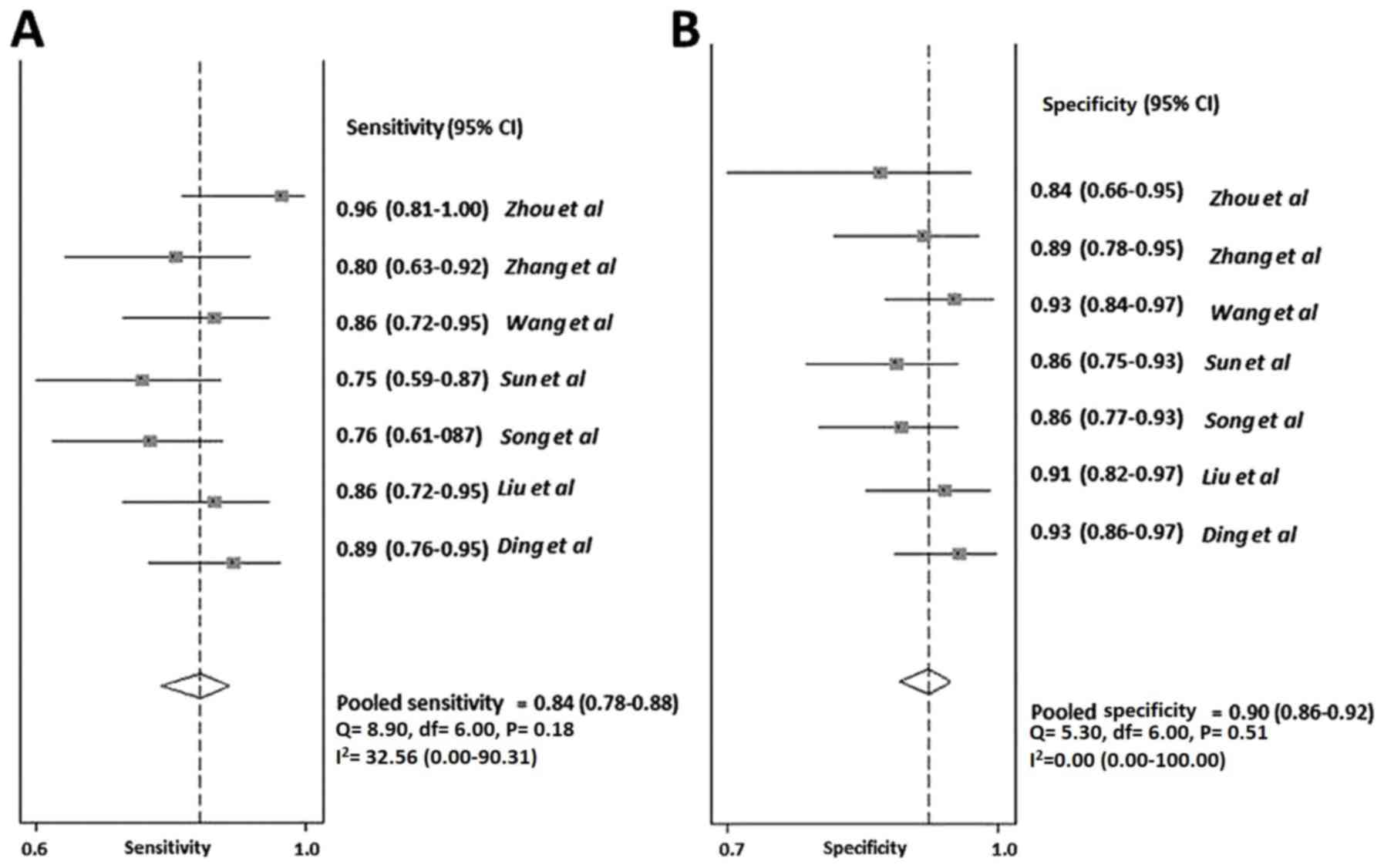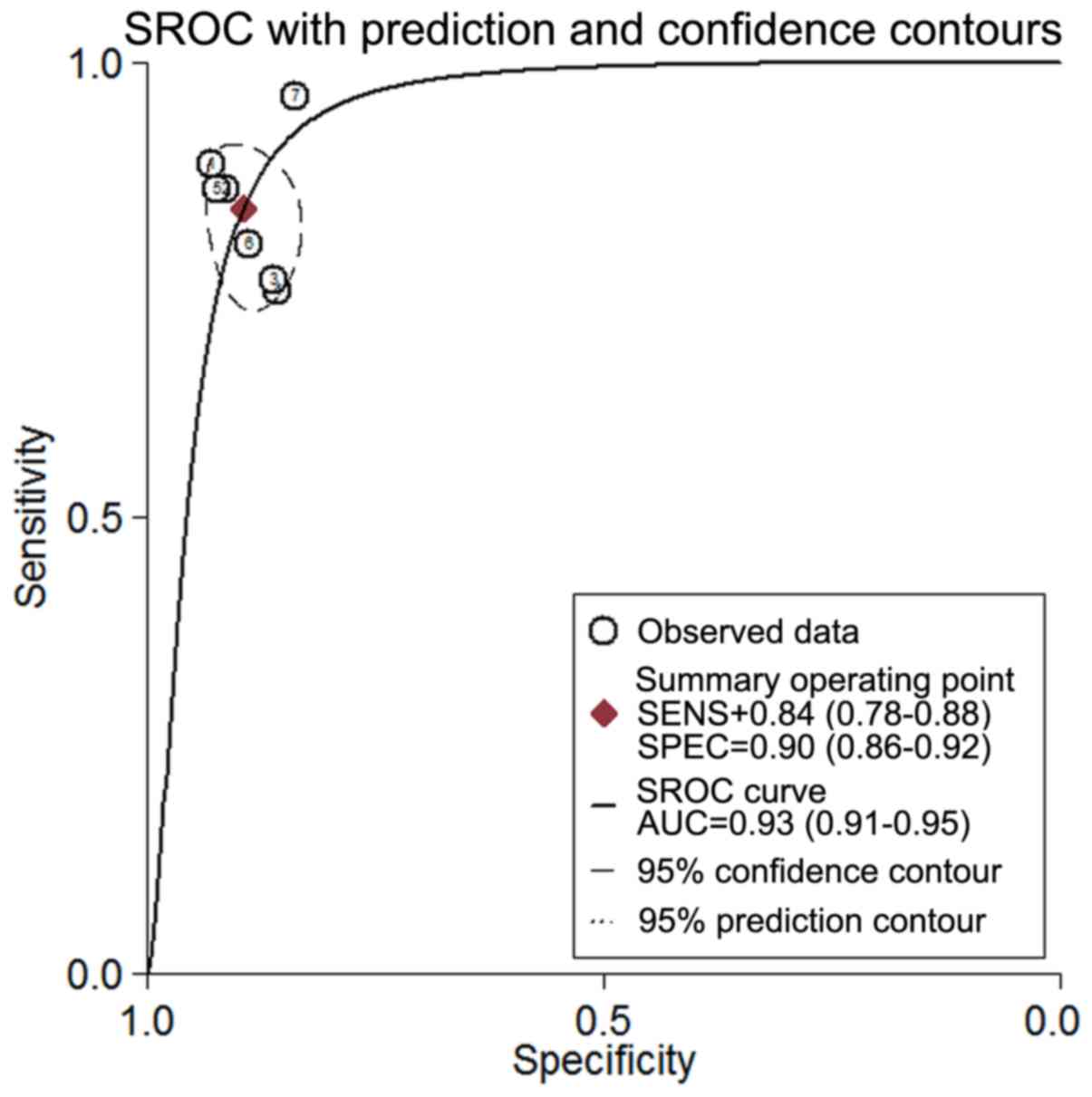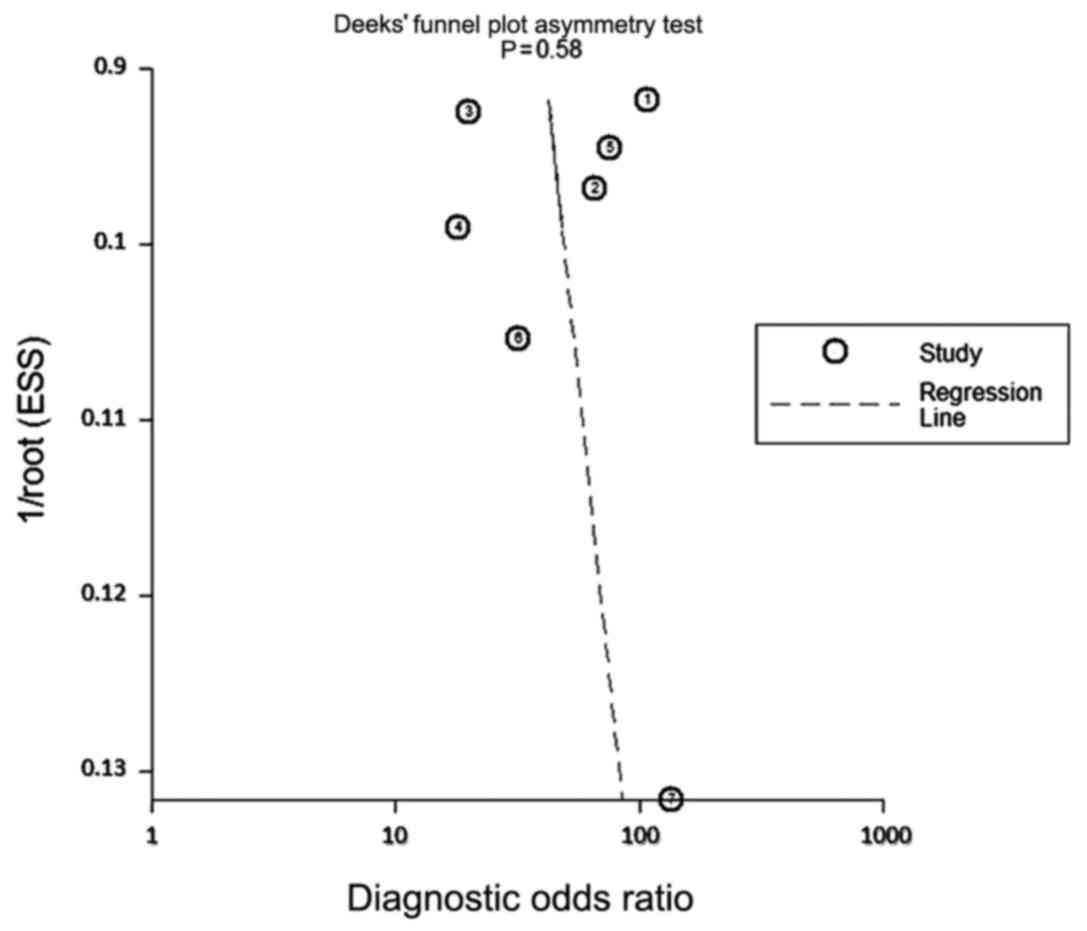Contrast‑enhanced ultrasound in the diagnosis of endometrial carcinoma: A meta‑analysis
- Authors:
- Published online on: October 22, 2018 https://doi.org/10.3892/etm.2018.6889
- Pages: 5310-5314
Abstract
Introduction
Among gynecological diseases, endometrial cancer (EC) is the most common one and a threat to the health of women worldwide; it usually occurs in perimenopausal women around the age of 50 years (1,2). Over the years, the incidence rate of EC has displayed a rising trend worldwide; however, the 5-year survival rate has gradually decreased (3). Since most patients with EC are at stage I at the time-point of diagnosis, pre-operative assessment provides benefits regarding the therapeutic strategy selection for EC.
Diagnostic methods for EC usually include ultrasonography, hysteroscopy and curettage. However, the rates of misdiagnosis and missed diagnosis are remain high (4). Common diagnostic methods, including curettage scraping (5), hysteroscopy (6), magnetic resonance imaging (7), positron emission tomography/computed tomography (8) or traditional transvaginal ultrasound (9), all have their advantages, as well as a certain insufficiency. Recently, contrast-enhanced ultrasonography (CEUS), which has been applied in the discrimination of benign from malignant adnexal masses (10,11), has attracted the attention of researchers and clinicians due to its potential in the diagnosis of EC. During the past 10 years, CEUS, which uses a microbubble contrast agent, e.g., SonoVue or Levovist, has significantly improved the diagnostic accuracy of ultrasonography in examining gynecological diseases, including ovarian tumors (12). Application of CEUS to determine myometrial invasion and the cancer stage in EC has also been reported in recent years; however, relevant studies remain inadequate.
To the best of our knowledge, to date, no previous study has summarized the accuracy of CEUS in the diagnosis of EC. In the present study, a meta-analysis was therefore performed to determine the accuracy of CEUS in diagnosing EC.
Materials and methods
Protocol
The present meta-analysis followed the Preferred Reporting Items for Systematic Reviews and Meta-Analyses (PRISMA) recommendations (13).
Study selection criteria
Prior to searching the literature, certain selection criteria were set for the studies to set standards for determining the diagnostic value of CEUS in EC. The selection criteria were as follows: i) The accuracy (sensitivity and specificity) of CEUS in the diagnosis of EC was evaluated; ii) a gold standard was adopted to treat and confirm EC, including surgery, histopathology and appropriate follow-up and iii) the data allowed for construction of a 2×2 table for true-positives, false-positives, true-negatives and false-negatives.
Literature search
Articles published until 31 January 2017 were retrieved from PubMed, EMBASE, Elsevier, Springer and Google scholar. The search terms were a combination of the following key words: ‘Ultrasonic angiography’, ‘endometrial carcinoma’, ‘contrast enhanced ultrasonography’, ‘sensitivity’, ‘specificity’, ‘positive predictive value’ and ‘negative predictive value’. A manual search was also performed through searching the reference lists of relevant articles to expand the number of included studies. In the case of insufficient data provided in a study, the authors were contacted. Only studies in English and Chinese language, which met the selection criteria, were included.
Data collection and extraction
Two independent observers reviewed abstracts to examine whether they qualified for inclusion according to the pre-defined criteria. Selected papers were then retrieved, evaluated for their eligibility, and relevant data were extracted by the two observers independently. A third observer was consulted when disagreements occurred. The following items were extracted according to a fixed protocol: Author, year of publication, country, study type, original study population, ultrasound modality and contrast agents. Diagnostic 2×2 contingency tables were constructed from the selected papers.
Statistical analysis
Pooled estimates of sensitivity, specificity, likelihood ratios [positive likelihood ratios, +LR=sensitivity/(1-specificity); negative likelihood ratios, -LR=specificity/(1-sensitivity)] and diagnostic odds ratios (DORs) were calculated in the present meta-analysis of the accuracy of CEUS in diagnosing EC. The fixed-effects model and the random-effects model were used and heterogeneity result was also recorded. The summary receiver operating characteristics (sROC) curve was also constructed. Confidence intervals were calculated using the F distribution method (14). Forrest plots were drawn to illustrate the distribution of the data-points in each study in association with the summary pooled estimate. The heterogeneity of the sensitivities and specificities were tested by applying the likelihood ratio test. Heterogeneity of the pooled studies was tested by using sROC curves as previously described (14). sROC curves were used to calculate the area under the curve (AUC). Publication bias was assessed using Deek's funnel plot asymmetry test, through P>0.05 suggesting no significant publication bias and with Review Manager 5.3 (Cochrane Collaboration, London, UK). All statistical analyses were performed using STATA 12.0 (STATA, College Station, TX, USA) except for the assessment of publication bias with Review Manager 5.3.
Results
Study collection and characteristics
The initial search identified 1,436 references, of which 93 relevant studies were selected and reviewed. After reviewing their abstracts, 52 studies were excluded. And after evaluation of the full-text articles, another 30 references were excluded. Among the 11 remaining studies, 4 did not meet the inclusion criteria due to insufficient sensitivity, specificity, accuracy or correlation values. Thus, 7 studies with a total sample size of n=275 were finally included in the present meta-analysis and their data were extracted (15–21). All selected studies are in accordance with the inclusion criteria. A flow chart depicting the selection process is presented in Fig. 1.
As indicated in Table I, the 7 included studies were published between 2008 and 2015. Among the studies, three were prospective studies and five were retrospective. The number of cases varied between 28 and 68. All studies used certain types of CEUS, including regular CEUS, color Doppler CEUS and combination of 2-dimensional (2D) and 3D CEUS. The microbubble contrast agent used in all studies was SonoVue. In all of the studies, CE was pathologically confirmed in addition to the diagnosis by CEUS.
Accuracy of CEUS in the diagnosis of EC
For the analysis CEUS accuracy in the diagnosis of EC, heterogeneity results demonstrated that the data was homogeneous with P=0.461. Thus, a fixed model in STATA was utilized. Parameters for the analysis of CEUS accuracy in the diagnosis of EC are shown in Table II. As presented in Fig. 2A and B, the pooled sensitivity of CEUS in the diagnosis of EC was 84% [95% confidence interval (CI), 0.78–0.88], while the pooled specificity was 90% (95% CI, 0.86–0.92). The positive likelihood ratio (+LR) of CEUS was 8.0 (95% CI, 5.9–10.8) and the negative likelihood ratio (-LR) was 0.18 (95% CI, 0.13–0.25). The DOR was 44 (95% CI, 26–77). The AUC under the sROC curve was 0.93 (Fig. 3). Moderate heterogeneity was observed for the sensitivity, specificity and DOR with I2 values of 32.56, 34.68 and 41.2%, respectively.
Assessment of bias
The publication bias was examined using Deeks' funnel plot asymmetry test (Fig. 4). No significant publication bias was observed for the DOR of CEUS in the diagnosis of EC (P=0.58). The result of the risk of bias assessment performed with Review Manager 5.3 is presented in Fig. 5. The results demonstrated that no study exhibited a high risk of bias in patient selection, index test, reference standard, trial process or timing of the studies.
Discussion
In recent years, CEUS has been proved to be efficient in the diagnosis of numerous diseases, e.g., liver cancer (22). In more recent years, the diagnostic value of CEUS in EC has gained the attention of researchers and clinicians. In China, an increasing number of clinicians choose to use CEUS to diagnose uterine lesions, including uterine fibroid (23). Sconfienza et al (24) studied the efficacy of CEUS in the diagnosis of uterine fibroids and demonstrated that CEUS was effective in determining the degree of vascular occlusion at the end of superselective uterine fibroid embolization procedures. Based on a study by Seitz and Strobel (25), CEUS was approved for diagnostic liver imaging in adults and children in the USA. However, compared with the application of CEUS in other fields, its use in the diagnosis of EC still requires further research.
In the present study, a meta-analysis was performed to summarize the accuracy of CEUS in diagnosing EC. Two reviewers were involved in the study to analyze the literature independently to reduce the bias of researchers. The meta-analysis also followed the PRISMA recommendations (13), which suggests that only studies containing at least four of the Quality Assessment of Diagnostic Accuracy Studies criteria (26) are included and in addition, all patients were confirmed by pathological analysis.
The present meta-analysis study provided a pooled sensitivity and specificity of 84% (95% CI, 0.78–0.88) and 90% (95% CI, 0.86–0.92), respectively, with a DOR of 44 (95% CI, 26–77) and an AUC of 0.93. Moderate heterogeneity was observed for the sensitivity, specificity and DOR. The present results suggest that CEUS has a high accuracy in the diagnosis of EC. Furthermore, the present meta-analysis indicated a high +LR of 8.0 (95% CI, 5.9–10.8) and a low -LR of 0.18 (95% CI, 0.13–0.25), suggesting that the diagnostic test performs well in correctly identifying the true disease state, which should also be confirmed by histopathological analysis. The publication bias was examined using bot Deeks' funnel plot asymmetry test and Review Manager 5.3, and no significant publication bias was observed.
Of note, the present study had several limitations. First, due to the limited number of cases and studies included, further evidences are still required. Furthermore, all studies that met the inclusion criteria for the meta-analysis were from China. This may be due to the application of CEUS having been widely adopted for diagnosing EC in China, but are not that common in other countries. Finally, the studies were limited by language, as the literature search only included those in English and Chinese.
In conclusion, the present meta-analysis indicates that CEUS is valuable in the diagnosis of EC. Additional clinical data and studies are still required to confirm the present results and to further develop the diagnostic application of CEUS in EC.
Acknowledgements
Not applicable.
Funding
No funding was received.
Availability of data and materials
The datasets used and/or analyzed during the current study are available from the corresponding author on reasonable request.
Authors' contributions
JG conducted the analysis and wrote the manuscript; and JT collected and performed a preliminary analysis of references, revised the manuscript, and approved it for submission.
Ethics approval and consent to participate
Not applicable.
Patient consent for publication
Not applicable.
Competing interests
The authors declare that they have no competing interests.
References
|
Dal Maso L, Augustin LS, Karalis A, Talamini R, Franceschi S, Trichopoulos D, Mantzoros CS and La Vecchia C: Circulating adiponectin and endometrial cancer risk. J Clin Endocrinol Metab. 89:1160–1163. 2014. View Article : Google Scholar | |
|
Wright JD, Barrena Medel NI, Sehouli J, Fujiwara K and Herzog TJ: Contemporary management of endometrial cancer. Lancet. 379:1352–1360. 2012. View Article : Google Scholar : PubMed/NCBI | |
|
Siegel RL, Miller KD and Jemal A: Cancer statistics, 2015. CA Cancer J Clin. 65:5–29. 2015. View Article : Google Scholar : PubMed/NCBI | |
|
de Boer SM, Nout RA, Jürgenliemk-Schulz IM, Jobsen JJ, Lutgens LC, van der Steen-Banasik EM, Mens JW, Slot A, Stenfert Kroese MC, Oerlemans S, et al: Long-term impact of endometrial cancer diagnosis and treatment on health-related quality of life and cancer survivorship: Results from the randomized PORTEC-2 trial. Int J Radiat Oncol Biol Phys. 93:797–809. 2015. View Article : Google Scholar : PubMed/NCBI | |
|
Kurosawa H, Ito K, Nikura H, Takano T, Nagase S, Utsunomiya H, Otsuki T, Toyoshima M, Nagai T, Tanaka S, et al: Hysteroscopic inspection and total curettage are insufficient for discriminating endometrial cancer from atypical endometrial hyperplasia. Tohoku J Exp Med. 228:365–70. 2012. View Article : Google Scholar : PubMed/NCBI | |
|
Crispi CP, Vanin CM, Dibi RP, Kato SK and Pesssini SA: Postmenopausal bleeding: Findings and accuracy of hysteroscopy and histopathologic in the diagnosis of endometrial cancer. J Minimal Invasive Gynecol. 18:S832011. View Article : Google Scholar | |
|
Bakir B, Sanli S, Bakir VL, Ayas S, Yildiz SO, Iyibozkurt AC, Kartal MG and Yavuz E: Role of diffusion weighted MRI in the differential diagnosis of endometrial cancer, polyp, hyperplasia, and physiological thickening. Clin Imaging. 41:86–94. 2017. View Article : Google Scholar : PubMed/NCBI | |
|
Bollineni VR, Ytrehauge S, Bollinenibalabay O, Salvesen HB and Haldorsen IS: High diagnostic value of FDG-PET/CT in endometrial cancer: Systematic review and meta-analysis of the literature. J Nucl Med. 57:879–885. 2016. View Article : Google Scholar : PubMed/NCBI | |
|
Jacobs I, Gentry-Maharaj A, Burnell M, Manchanda R, Singh N, Sharma A, Ryan A, Seif MW, Amso NN, Turner G, et al: Sensitivity of transvaginal ultrasound screening for endometrial cancer in postmenopausal women: A case-control study within the UKCTOCS cohort. Lancet Oncol. 12:38–48. 2011. View Article : Google Scholar : PubMed/NCBI | |
|
Palmieri VO, Santovito D, Marano G, Minerva F, Ricci L, D'Alitto F, Angelelli G and Palasciano G: Contrast-enhanced ultrasound in the diagnosis of hepatocellular carcinoma. Radiol Med. 120:627–633. 2015. View Article : Google Scholar : PubMed/NCBI | |
|
Dietrich CF, Averkiou MA, Correas JM, Lassau N, Leen E and Piscaglia F: An EFSUMB introduction into dynamic contrast-enhanced ultrasound (DCE-US) for quantification of tumour perfusion. Ultraschall Med. 33:344–351. 2012. View Article : Google Scholar : PubMed/NCBI | |
|
Wang J, Lv F, Fei X, Cui Q, Wang L, Gao X, Yuan Z, Lin Q, Lv Y and Liu A: Study on the characteristics of contrast-enhanced ultrasound and its utility in assessing the microvessel density in ovarian tumors or tumor-like lesions. Int J Biol Sci. 7:600–606. 2011. View Article : Google Scholar : PubMed/NCBI | |
|
Moher D, Liberati A, Tetzlaff J, Altman DG and PRISMA Group: Preferred reporting items for systematic reviews and meta-analyses: The PRISMA statement. Ann Intern Med. 151:264–269. 2009. View Article : Google Scholar : PubMed/NCBI | |
|
Puli SR, Kalva N, Bechtold ML, Pamulaparthy SR, Cashman MD, Estes NC, Pearl RH, Volmar FH, Dillon S, Shekleton MF and Forcione D: Diagnostic accuracy of endoscopic ultrasound in pancreatic neuroendocrine tumors: A systematic review and meta-analysis. World J Gastroenterol. 19:3678–3684. 2013. View Article : Google Scholar : PubMed/NCBI | |
|
Wang AZ, Liu CY, Xie Q and Wu XP: Contrast-enhanced ultrasound and magnetic resonance imaging diagnosis value and differential diagnosis for myometrial invasion of stage I endometrial carcinoma. Shaanxi Yi Xue Za Zhi. 41:80–83. 2012.(In Chinese). | |
|
Zhou HL, Xiang H, Duan L, Shahai G, Liu H, Li XH and Mou RX: Application of combined two-dimensional and three-dimensional transvaginal contrast enhanced ultrasound in the diagnosis of endometrial carcinoma. Biomed Res Int. 2015:2927432015. View Article : Google Scholar : PubMed/NCBI | |
|
Song Y, Yang J, Liu Z and Shen K: Preoperative evaluation of endometrial carcinoma by contrast-enhanced ultrasonography. BJOG. 116:298–299. 2009. View Article : Google Scholar | |
|
Ding Y, Guo Y, Guan L, Wang H, Zhang D and Wang Y: Application value of contrast-enhanced ultrasound for stage of endometrial carcinoma. Chongqing Med J. 42:2103–2106. 2013. | |
|
Liu CY, Wang XF, Xie Q, Wan BB, Sheng X, Wang M and Zhao LH: Diagnostic value of contrast-enhanced ultrasound for myometrial invasion of stage I endometrial carcinoma. Chinese J Med Image Technol. 27:1443–1446. 2011. | |
|
Sun ZJ, Yang JX, Shen K, et al: Contrast-enhanced ultrasound in the evaluation of myometrial invasion in endometrial carcinoma. J Reproduct Med. 2008. | |
|
Zhang XZ, Zhao HY, Peng M and Wei WB: Application of contrast-enhanced ultrasound in the myometrial invasion of endometrial carcinoma. J Bengbu Med Col. 36((3)): 285–287. 2011. | |
|
Lencioni R, Piscaglia F and Bolondi L: Contrast-enhanced ultrasound in the diagnosis of hepatocellular carcinoma. J Hepatol. 48:848–857. 2008. View Article : Google Scholar : PubMed/NCBI | |
|
Zhou XD, Ren XL, Zhang J, He GB, Zheng MJ, Tian X, Li L, Zhu T, Zhang M, Wang L and Luo W: Therapeutic response assessment of high intensity focused ultrasound therapy for uterine fibroid: Utility of contrast-enhanced ultrasonography. Eur J Radiol. 62:289–294. 2007. View Article : Google Scholar : PubMed/NCBI | |
|
Sconfienza LM, Lacelli F, Gazzo P, Gandolfo N, Gravano M and Serafini G: Is contrast-enhanced ultrasound (CEUS) effective in the assessment of outcomes and in the follow up of uterine fibroids after superselective uterine fibroids embolization (SUFE) when compared to dynamic magnetic resonance (MR)? Ultraschall in Der Medizin. 29((S1))2008. | |
|
Seitz K and Strobel D: A Milestone: Approval of CEUS for diagnostic liver imaging in adults and children in the USA. Ultraschall Med. 37:229–232. 2016. View Article : Google Scholar : PubMed/NCBI | |
|
Whiting P, Rutjes AW, Reitsma JB, Bossuyt PM and Kleijnen J: The development of QUADAS: A tool for the quality assessment of studies of diagnostic accuracy included in systematic reviews. BMC Med Res Methodol. 3:252003. View Article : Google Scholar : PubMed/NCBI |














